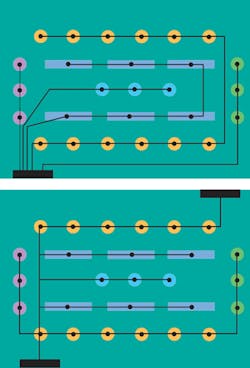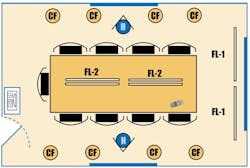Get the Most out of Fluorescent Dimming
When used correctly, the purpose of a lighting-control system is to eliminate energy waste while providing a productive visual environment. To accomplish this, controls can provide the right amount of light where it's needed and when it's needed - either automatically or at the discretion of users. According to the White Salmon, WA-based New Buildings Institute, lighting controls can reduce lighting energy consumption by 50 percent in existing buildings and by at least 35 percent in new construction.
Automatic shut-off strategies (either time-based switching using an intelligent control panel for scheduling on/off or threshold-based switching using occupancy sensors) have become standard in commercial construction due to the proliferation of energy codes. According to the Sacramento, CA-based California Energy Commission, scheduling can produce 5- to 10-percent energy savings, and up to 15-percent savings when using bi-level switching (manual or automatic control [or a combination] that provides two levels of lighting power in a space). According to San Francisco-based Pacific Gas and Electric (PG&E) Co., occupancy sensors can produce typical savings of 35 to 45 percent.
Dimming is not specifically required by code (although it is a qualifying bi-level switching strategy within the Intl. Energy Conservation Code, which has been adopted by a large number of states), but produces real benefits. The most notable trend in dimming is reliable dimming of fluorescent lighting. Fluorescent lamps were not originally designed to be dimmed by their ballasts. The first dimming ballasts were magnetic and offered limited dimming range and other performance tradeoffs. With the advent of electronic dimming ballasts, efficient and reliable performance can be achieved without the tradeoffs associated with magnetic ballasts.
Dimming, like any lighting option, presents its own particular challenges and potential tradeoffs. For this reason, building owners and managers should seek expert advice before making any decision related to lighting and lighting controls to ensure a successful application.
Control Strategies
Fluorescent dimming systems can satisfy the visual needs of the space, change light levels without disrupting operations, support worker satisfaction with personal control, and reduce utility costs through daylight harvesting, demand reduction, scheduled dimming, and other strategies. These opportunities typically boil down to either strategies that enable users to manually select light levels based on their needs and preferences or strategies that automatically reduce light levels based on an energy-saving opportunity such as available daylight or time-of-day scheduling.
The classic use of dimming is in a conference room, classroom, auditorium, training center, or similar space: Dimming the lights in these spaces can support a variety of visual presentations. This saves energy, but the primary purpose is to satisfy variable visual needs across a broad, continuous range. Similarly, in other applications, such as restaurants and bars, dimming can be used for setting a mood; in healthcare facilities, dimming enables nighttime patient care with lower illumination levels. In an open discount retail space with daylighting, dimming can reduce lighting use while still allowing the lights to be on, making the store appear "open for business."
In applications with daylighting, photocontrol dimming can provide a smooth and unnoticeable transition to lower electric light levels as daylight levels increase, all while maintaining the desired light level to produce significant lighting energy savings. The New Buildings Institute states that daylight-harvesting systems can generate a maximum potential savings of 35 to 60 percent, but can "easily save 10 to 50 percent of annual lighting energy" in suitable spaces. The Seattle-based Lighting Design Lab states that savings can reach 40 to 60 percent, but some spaces - such as offices, classrooms, and gymnasiums - can save 60 to 80 percent. According to the U.S. Department of Energy, when coupled with skylights, daylight-response switching has demonstrated energy savings in warehouses of 30 to 70 percent.
In office areas, giving occupants the ability to select lighting levels to suit their personal needs and preferences has been demonstrated in research to produce energy savings while increasing worker satisfaction. People exhibit a wide variance in their preferences for lighting levels. And, as the American workforce ages, this variance will likely increase, as older people need more light for visual acuity. Research demonstrates that many building occupants are unsatisfied with their lighting and want more control of it. Personal control, achieved through dimming or switching, is now encouraged by the Washington, D.C.-based U.S. Green Building Council's Leadership in Energy & Environmental Design (LEED) rating system.
Demand-response applications are also appropriate for fluorescent dimming. Utility demand-side management strategies often focus on installing newer, energy-efficient lighting equipment instead of older, less-efficient equipment, but utilities are less interested in reducing overall demand than they are in reducing peak demand. Because of the high cost of maintaining capacity to satisfy peak demand, these costs are passed on to building owners, usually through a demand charge. In some states, these demand charges can be very high, and sometimes even eclipse energy charges.
If a building's lighting can be dimmed based on a centralized command, the facility's load can be reduced during any scheduled time of day; if this occurs during peak-demand periods, it can produce lower demand charges. In addition, it may be possible to work with the utility to reduce load through dimming on demand by the utility during emergencies or sudden demand spikes in exchange for more favorable electric rates. Dimming is ideally suited to demand response because no lighting systems have to be switched off to reduce load, reduce demand charges, or ease pressure on the grid.
There are many potential applications for dimming. Strategies can be combined to provide greater energy savings, and they can be economically achieved because a number of strategies have overlapping devices.
The Dimmable Ballast
The ballast is an essential part of every linear fluorescent and compact fluorescent lighting system, providing the starting voltage to ignite the lamp and then regulating current flowing through the lamp after start-up; similarly, the dimmable ballast is at the heart of a fluorescent dimming system. To achieve dimming, a ballast can be designed so that it can receive a control signal from a dimmer as an input and adjust the current flowing through the lamp as an output, resulting in a dimming effect - lower electrical input and light output at the desired level.
Typically, there is a linear relationship between the dim level and light output. For example, a 20-percent dim level will result in 20 percent of the original light output. How far the ballast can go in dimming down toward 0 percent depends on the ballast; it also helps to categorize them. Energy management application ballasts (e.g. daylight-harvesting ballasts) typically provide a dimming range from 100 percent to between 5 and 10 percent of light output; premium architectural dimming application ballasts (e.g. in a conference room or training center) provide 100 to 1 percent of light output.
The dimming range for a ballast can be affected by which lamp type it's operating. For example, a 0-10VDC ballast operating 32-watt T8 lamps may be at a dimming range of 100 to 3 percent, while the range for a 0-10VDC ballast operating 54-watt T5HO lamps may be 100 to 1 percent.
While there is a linear relationship between dim level and light output, there is not necessarily a linear relationship between dim level and electrical input. For example, a 20-percent dim level does not mean that the system is drawing 20 percent of the original wattage; during a large part of the dimming range, efficiency is lost. So, although energy savings can be achieved down to about a 20-percent dim level, efficacy (lumens of light output per watt of electrical input) has declined.
Dimmable electronic ballasts are available in 1-, 2-, 3- and 4-lamp models that operate linear rapid-start T8 lamps, and in 1- and 2-lamp models that operate linear and twin-tube T5 and T5HO lamps. Dimming is currently not available for operating certain high-performance T8 lamps (25-watt, 28-watt, and 30-watt models). The ballast may be rapid-start (requiring rapid-start lamp sockets in the light fixture) or programmed-start rapid-start (designed to optimize lamp life in applications where the lighting is frequently switched, such as in occupancy-sensor installations).
Dimming Methods
How the ballast accomplishes the dimming effect is called the "dimming method," which ensures interoperability between all ballasts and control devices in the same system as long as they are rated as compatible by their manufacturers. The dimming method is a critical decision because, once it's determined, all control devices interacting as part of the dimming system must be designed as compatible with that dimming method. Not only should devices designed for other dimming methods not be placed in the same load operated by a fluorescent dimmer, but neither should non-dimmable ballasts or other types of loads, such as incandescent.
Primary dimming methods include analog, which is currently the most popular, and digital, which is still emerging.
Analog Dimming
Analog methods, discussed below, each present a particular mix of advantages and disadvantages.
- Analog 0-10VDC ballasts utilize low-voltage wiring to connect to associated control devices in the system and, therefore, are easily scaled to local control or integration into centralized energy-management systems that include other devices such as scheduling panels and occupancy sensors. As the most popular dimming ballast type, 0-10VDC ballasts are ideally suited for energy-management applications and are available from most major ballast manufacturers with a wide range of compatible controls.
- Two-wire phase-control ballasts utilize existing line-voltage wiring for transmission of the control signal, avoiding the need for low-voltage wiring and making this ballast choice economical for retrofits and ideally suited to standalone applications.
- Three-wire phase-control ballasts utilize an additional control wire and, with a dimming range of 100 to 1, are considered premium architectural ballasts.
- Wireless infrared dimming provides individual control that can also be integrated into energy-management systems, suitable for new construction and retrofit. It uses an IR transmitter to perform the control function and does not require additional wires; the dimmer is either in the ballast or in an additional device in the light fixture.
Digital Dimming
Digital dimming, either based on a proprietary digital or DALI (open) protocol, is an emerging technology with significant promise. The HVAC industry began embracing Direct Digital Controls (DDC) in the early 1990s. With digital electronic ballasts, this technology is now available for lighting. Digital dimming offers a number of advantages compared to analog dimming and can be used for both dimming and automatic shut-off. These advantages are simplified wiring, the ability to economically set up very small control zones and reconfigure them without rewiring, and two-way communication with some ballasts.
The digital dimming control system in this conference room includes the following components:
-
2 1xF32T8 dimming ballasts (FL-1).
-
2 2xF28T8 dimming ballasts (FL-2).
-
8 1xCFQ26W dimming ballasts (CF).
-
2 electronic halogen dimming modules (H).
-
1 wall-mounted 4-scene recall controller.
-
1 handheld programmable remote.
-
1 power supply.
In this space, light levels can be controlled so that the side of the room where presentations occur can receive more or less illumination depending on the media used. The handheld remote is used for zone programming as well as programming scenes and recall. COURTESY OF UNIVERSAL LIGHTING TECHNOLOGIES
Digital dimming utilizes low-voltage wiring for transmission of the control signal, but a single set of wires forms the control bus, which simplifies wiring compared to 0-10VDC and can result in installation savings even though the component cost of the ballast is typically higher than other dimming ballast types. Additional installation savings can be realized in larger installations because a dimming panel is not required. DALI-compatible dimming ballasts can dim from 100 to 1 percent and are currently available in 1-, 2-, 3- and 4-lamp models for T8 lamps, and 1- and 2-lamp models that operate T5, T5HO, and compact fluorescent lamps, including universal voltage input models, from most major ballast manufacturers.
When designing a control system, a critical decision is the size of the control zone (a group of lighting fixtures controlled simultaneously by the same control device); generally, smaller zones mean more control accuracy, flexibility, and energy savings, but higher cost. With a digital dimming system, these zones are established using software by individually addressing and grouping ballasts, enabling control zones as small as single fixtures, which is particularly advantageous with applications such as daylight harvesting. As space needs change in the future, these control zones can be reconfigured again using software, avoiding the need to rewire the ballasts and providing ultimate flexibility.
And, with two-way communication, the ballast can communicate information to a central control computer to identify lamp and ballast failures (to simplify and facilitate maintenance), and report energy usage. DALI-based digital lighting networks can be integrated into building-automation systems using a gateway device, which acts as a translator.
These advantages often entail tradeoffs in complexity. For example, digital control presents more sophisticated programming when centralized systems are used and requires on-site field commissioning. During the start-up phase, a database of ballast addresses, with physical locations and the control device that operates them, needs to be created and then maintained when the space changes. It may be advisable to involve IT staff in the creation and maintenance of this database.
Commissioning
Properly designed, installed, and operated fluorescent dimming systems are neutral regarding lamp life and do not cause lamp flicker, flashing, or other visual instabilities. That being said, more fluorescent lighting-control problems occur during dimming than switching. Often, these problems can be traced back to faulty wiring, mismatched components, poor lamp contact with the socket, and other design and installation issues. In addition, a system built from components from different manufacturers may not operate to design intent after installation or fulfill its energy-savings potential. For these reasons, it is recommended that you commission dimming equipment (and all other lighting controls) after installation to satisfy design intent and owner needs (see table below for basic steps).
| Common Commissioning Activities | |
| Control Type | Calibration and Commissioning Activities |
| All | Ensure that sensors are properly located and oriented per specifications and/or construction drawings. |
| Dimming systems | For best results, it is recommended that newly installed fluorescent lamps be "seasoned" prior to dimming, which means operating them at full light output for a period of time before they are dimmed. This irons out impurities in fluorescent lamp residual from the manufacturing process that can cause flicker. The Rosslyn, VA-based National Electrical Manufacturers Association (NEMA) recommends that, when new linear lamps are installed, they be operated at full light output overnight (about 12 hours) to achieve optimal performance in installations where dimming performance (e.g. tracking, stability) is critical. |
| Daylight harvesting | All furnishings and interior finishes and materials should be installed before calibrating the sensors. Adjust the photosensor to determine the threshold for switching based on detected light level. It may be helpful to calibrate under normal daylight conditions and dusk conditions (it may be possible to close window blinds to approximate dusk). Record the calibration adjustments if possible and replicate in similar spaces. |
| Manual dimming | Ensure correct placement of the dimmer adjacent to the wall switch per the construction drawings. Adjust the upper limit of the dimming range according to the task being performed; set the lower limit of the range so that the minimum level meets the use/application of the space. |
Commissioning entails systematically testing all controls in the building to ensure that they provide specified performance and interact properly as a system. It may involve all members of the team and is typically led by the commissioning agent, who may be a contractor, a commissioning specialist, a manufacturer, or another professional. Be sure to plan and budget for commissioning as part of the design and construction process.
After commissioning is completed, tell the users about the intent and functionality of the controls. This is critical - if users do not understand the controls, they may bypass them. The maintenance department should receive documentation and instructions so that they can maintain and retune the system as needed.
Craig DiLouie, a lighting industry journalist, analyst, and marketing consultant, is principal at New York City-based ZING Communications Inc. (www.zinginc.com) and is acting executive director of the Rosslyn, VA-based Lighting Controls Association (www.aboutlightingcontrols.org).




